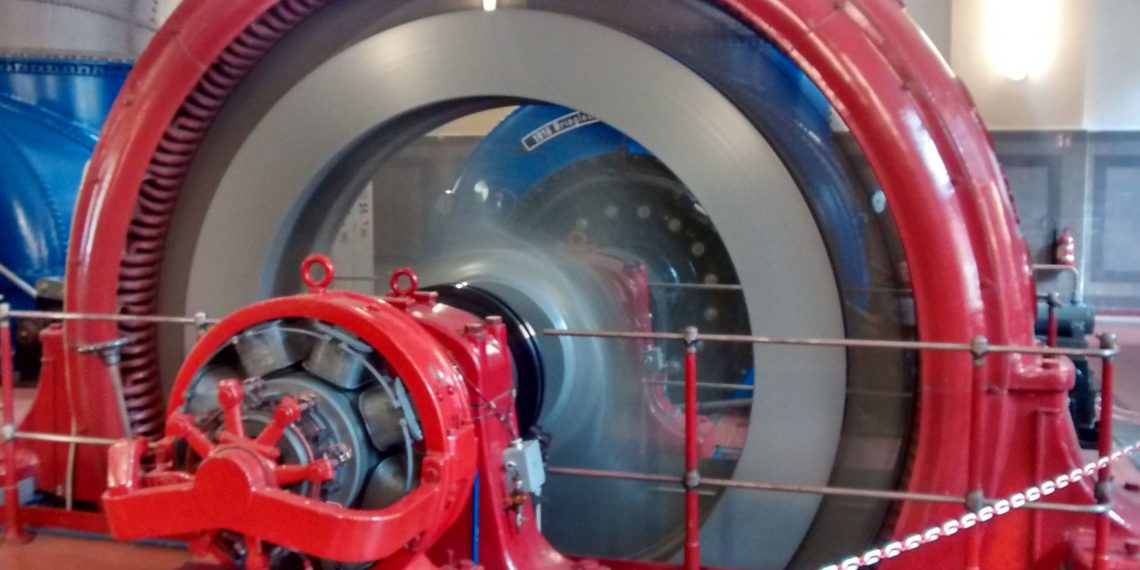In 2022, the last nuclear power plants in Germany will be taken off the grid — meaning that the power supply system will also lose instantaneous reserve. This system service — in addition to control power — ensures the stability of the grids in the event of disruptions. As a study by the RWTH Aachen University has now shown, the hydropower plants in Germany can compensate for a disruption, for example due to an unplanned power plant outage of up to 500 megawatts (MW), in terms of instantaneous reserve. This corresponds to the output of a medium-sized coal-fired power plant. They thus make a relevant contribution to future grid stability and security of supply.
Instantaneous reserve is the term used to describe the power reserve available without delay in a power transmission system. It results from the inertia of the rotating flywheel masses of the synchronous generators of conventional power plants. If there is an abrupt change in load in a power grid, the power deficit cannot be compensated immediately by regulating power plant output. This is because this is always associated with a certain delay time. Therefore, in order to prevent instabilities and interruptions, sufficient kinetic energy from rotating flywheel masses of power plants must be available in the supply system immediately after the disturbance.
Hydropower plants as a balance to volatile power generators
From the point of view of generation volumes, wind energy and photovoltaic plants are considered to be the main pillars of future renewable energy production. However, these plants, which are usually connected by power electronics, do not yet provide instantaneous reserve according to the current state of the art. Hydroelectric power plants, on the other hand, are capable of doing so.
A team led by Professor Albert Moser, Chair of Transmission Networks and Energy Economics at the Institute of Electrical Systems and Networks, Digitalization and Energy Economics (IAEW) at RWTH Aachen University, has now determined and quantified the instantaneous reserve of hydropower plants in Germany. The calculations are based on 7,988 hydropower plants with a total of 6.28 gigawatts net nominal capacity recorded in the market master data register of the Federal Network Agency. Among other things, the scientists determined the stored kinetic energy of the hydropower plants, which can be determined from the inertia constant and the rated power of the generators.
According to the calculations, a kinetic energy of around 10.32 gigawatt seconds (GWs) is stored in the rotating masses of the hydropower plants in Germany. By way of comparison, the Weisweiler Block H lignite-fired power plant has a kinetic energy of 2.4 GWs, while the Isar/Ohu 2 nuclear power plant has 8.88 GWs. The kinetic energy provided by the hydropower plants thus corresponds to the instantaneous reserve of a nuclear power plant.
The study was led by Martin Knechtges and Stefanie Samaan. It further shows that a disturbance event of 462.5 MW could be absorbed by the hydropower plants alone in terms of instantaneous reserve, taking into account the frequency dependence of the grid loads. Their held instantaneous reserve is sufficient to sufficiently limit the resulting frequency change rate and deviation. “German hydropower plants also contribute at this level to the control of larger power deficits, for example grid disconnections. Further contributions to mastering must then still be provided from other plants,” summarizes Martin Knechtges, research associate at IAEW.
Small decentralized hydropower plants stabilize Bavarian power grids
In addition, the researchers point out, particularly for Bavaria, that in terms of future grid structures and the self-sufficient supply of small cellular grids, the decentralized hydropower plants available can contribute to stable grid operation.
“The study shows once again that hydropower plants fulfill important system services for grid stabilization, especially against the background of the shutdown of nuclear power plants in 2022 and subsequently of coal-fired power plants. In addition to instantaneous reserve, black start capability is also worth mentioning in this regard, for example.”
- Fritz Schweiger, Chairman of the Board of the Association of Hydropower Plants in Bavaria (VWB) e.V.
This means that after a large-scale power outage, hydropower is technically capable of supporting the reconstruction of the power supply. “However, the study also shows that existing hydropower alone cannot provide the necessary momentary reserve in the power supply system. Expanding electricity generation from hydropower would already have an efficient solution component for this. However, the other renewable energy sources will also have to make their contribution in the future. Now it is up to the engineers to find out how this can be ensured with modern power electronics,” states Detlef Fischer, Managing Director of the Association of Bavarian Energy and Water Industries (VBEW) e.V..
The study “Determining the instantaneous reserve of hydropower plants in Germany” at the Institute of Electrical Systems and Networks, Digitalization and Energy Economics at RWTH Aachen University was carried out on behalf of the German Hydropower Association (BDW) e.V., the “Hydropower Yes Please!” initiative in the Bavarian Energy and Water Management Association (VBEW) e.V. and the NRW Water Utilization Interest Group.

















